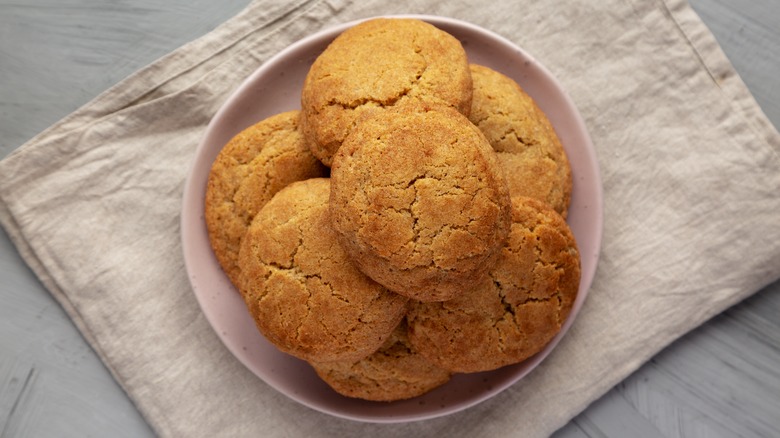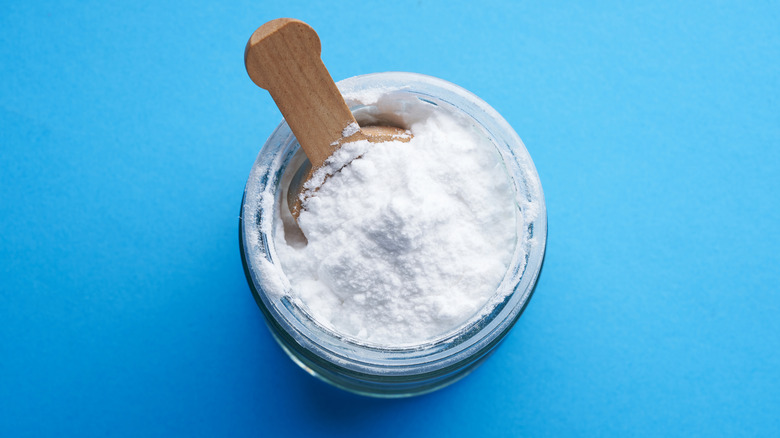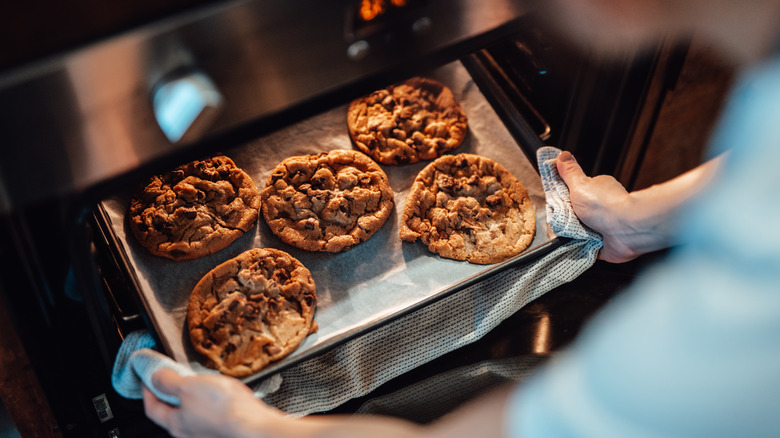The Science Behind Using Baking Soda In Cookies
Imagine two recipes for sugar cookies, set side by side. They both contain basically the same ingredients: all-purpose flour, granulated white sugar, a couple eggs, a bit of vanilla extract. And they each contain a leavening agent — the thing that makes pastries rise. In one recipe, it's baking powder. In the other, it's baking soda.
Baking soda and baking powder are not interchangeable. And here you see why: Baking-powder sugar cookies are ultimately rolled out and cut with cookie cutters before being baked. They emerge from the oven in more or less the shape they went in — maybe puffed up slightly. When you bite into one, you encounter something relatively crisp and dry. They take well to icing.
Baking-soda sugar cookies are another matter entirely. They're dropped onto the baking sheet by the spoonful, and when they come out of the oven, they're moist and chewy. While baking-powder cookies look smooth on top, these guys are crackly. They're both great cookies, but two entirely different animals.
It all comes down to science — specifically, the science of baking soda, which interacts with acidic ingredients in cakes, cookies, muffins, pancakes, and the like to create delicious pastries. It's a key ingredient in baking powder. Put another way, you can have baking soda without baking powder, but baking powder without baking soda is impossible. So: How does baking soda work, and how does it affect your cookies? Let's dive in.
What's baking soda (and what's baking powder)?
Most pastry doughs and batters rely on some form of leavening — the thing that makes them rise, creating something light and airy rather than dense and chewy. The classic leavener is yeast. Before it was available commercially, bakers harvested it from the air around them. If that sounds familiar, it's because it's what you do when you make a sourdough starter.
Baking soda and baking powder are known as chemical leaveners, though they come from natural sources. Baking soda, aka sodium bicarbonate, is from a mineral called trona. Fun fact: According to the Wyoming Mining Association, the world's largest trona deposits are in Wyoming, which has enough of this stuff — 40 billion recoverable tons — to meet the world's current demand for the next 2,350 years. It's not just for pastries, either — baking soda is also a cleaning superstar that can make your tomato-stained containers look good as new.
If you've ever combined baking soda (an alkaline) and vinegar (an acid), you're aware of the ensuing chemical reaction: The two create carbon dioxide, which in the classic school-volcano experiment means fizzing up wildly. That's the same reaction, essentially, that occurs in cakes and cookies. The leavener reacts with an acid to produce carbon dioxide, which takes advantage of tiny air pockets in the dough — created through the creaming of butter and sugar — to expand and cause the dough to rise. What's baking powder? Simply baking soda with an acid (like cream of tartar) already mixed in. You can add it to doughs that don't otherwise have an acidic component.
Baking powder vs. baking soda in your cookies
The first acidic ingredients that spring to mind might be obviously sour, like buttermilk. But ingredients like cocoa powder and brown sugar are also acidic. While acidic liquids begin their reaction as soon as they come into contact with baking soda, dry acids like brown sugar don't create a reaction until everything starts to melt together in the oven. That's one reason that unbaked cookie doughs — unlike most cake batters, with their liquid acids — can be stored in the refrigerator or freezer.
Baking soda plays another crucial role in cookies: It raises the pH of the dough, lengthening the amount of time it takes the proteins to firm up as they bake. Consequently, the dough gets a chance to spread out more — compared to, say, a recipe with only baking powder — and cook more evenly. By raising the alkalinity of dough, baking soda also helps browning and weakens gluten strands, promoting a more tender cookie.
The upshot is this: Baking powder tends to make cakier cookies, whereas baking soda produces chewier cookies — hence the sugar-cookie examples up top. When you see a recipe including both, that might be because it was written with a variety of desirable traits in mind: The perfect mix of chewiness and cakiness, and the optimized chemical reaction between the acidity of something like brown sugar and the alkalinity of baking soda. Whatever direction you go in, the results will probably be pretty sweet.


